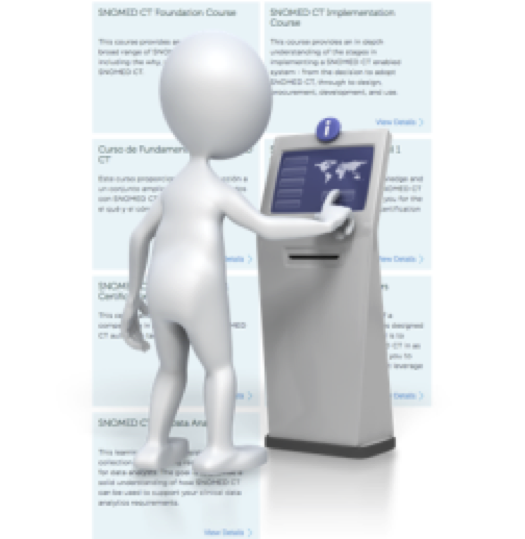Terminology Services Certification Exam Guide
| Site: | SNOMED CT E-Learning Platform |
| Course: | Course Information |
| Book: | Terminology Services Certification Exam Guide |
| Printed by: | Guest user |
| Date: | Sunday, 1 June 2025, 7:46 PM |
1. Introduction
Welcome to the SNOMED CT Terminology Services Certification Exam Guide!
To achieve this certification, you must pass an exam which tests the knowledge and practical skills covered in the Terminology Services Course which we recommend is completed prior to the exam. Please click here to view the Terminology Services Competencies required prior to taking the exam.
This guide will cover the following:
- Enrolment onto the Exam
- Exam preparation
- Completion of the exam
- After the exam
If you have any questions or issues throughout the course, please contact us by email at elearning@snomed.org.
1.1. Terminology Services Course and Exam Overview
|
Appropriately skilled experts are needed to support the development of software solutions that access and utilize the power of SNOMED CT services in a convenient and effective manner. To support the training and certification of these experts, SNOMED International offers the SNOMED CT Terminology Services Course and Terminology Services Certification Exam. The SNOMED CT Terminology Service Certification Course and Exam enables software professionals to develop the competencies required to become a SNOMED CT terminology service expert. It also gives software professionals an opportunity to be recognized for the terminology services skills and knowledge they acquire through the course by offering a certification process. This certification program may be valuable to both new and experienced developers of SNOMED CT enabled systems. The course provides the learning material required to prepare for the certification exam. However, please note that the completion of the training material does not guarantee that you will pass the certification exam. Additional practice and experience may be needed to reach the standard required for certification. |
 |
1.2. Prerequisites
No prior knowledge of SNOMED CT is needed before enrolling in this certification exam.
However, we would highly recommend completing the Terminology Services Course prior to taking the exam.
To effectively participate in the Terminology Services course and The Terminology Services exam you should have an understanding of retrieving, querying and updating data via REST APIs using JSON or XML. Knowledge of the cURL command-line tool for getting or sending data using URL syntax is not required but may be helpful.
The eLearning team will not provide technical support related to the understanding of REST APIs, HTTP methods, cURL, JSON, or XML.
Here are some references you can use to learn or refresh your knowledge about REST APIs:
1.3. Communication
|
To communicate with the SNOMED International E-Learning team, please email elearning@snomed.org. Using this elearning email address will ensure that your communications are tracked and managed in a way that allows the team to respond most effectively. If you are reporting an issue, please remember to provide screenshots (where applicable) and a detailed explanation. To receive important email communications related to your e-learning, please ensure that your email client is not placing messages from noreply@snomed.org or elearning@snomed.org in a spam or junk folder. If you are experiencing any technical issues while your certification exam is in progress, please email certsupport@snomed.org. We will try to respond to these emails as quickly as we can, but please be aware that the response may not be immediate. When you finish the Terminology Services Certification Course, please complete the course feedback form to share your comments and suggestions. |
 |
2. Certification
The SNOMED CT Terminology Services certification is a formal recognition of your competence in using SNOMED CT terminology services to search and retrieve SNOMED CT content.
Certification from SNOMED International allows professional software developers to demonstrate that they possess the knowledge and skills required to effectively use SNOMED CT terminology services.
Certification is valid for 3 years. To retain your certification beyond this time, you must resit and pass the Terminology Services Certification Exam.
2.1. Enrolment
|
To enrol in this certification exam, please login to the E-Learning Platform, visit the SNOMED CT Course Catalogue and select the SNOMED CT Terminology Services Certification Exam product. Students who live in a SNOMED International Member country or territory will receive a 50% discount on their enrolment fee. This discount is applied after you have logged into your SNOMED CT E-Learning account. |
|
2.2. Preparation
|
To prepare for the certification exam, please follow these steps:
|
 |
2.3. Exam
|
The SNOMED CT Terminology Services Certification Exam consists of 20 questions which test the competencies outlined in the Terminology Services Competencies.
You have up to 5 hours to complete the exam. If you are experiencing any technical issues while your certification exam is in progress, please email certsupport@snomed.org. We will try to respond to these emails as quickly as we can, but please be aware that the response may not be immediate. RulesPlease read the certification rules to understand the rules of sitting a SNOMED International certification exam. Acceptance of and adherence to these rules is mandatory when participating in a SNOMED International certification exam. |
 |
Proctoring
The Terminology Services Certification Exam uses a remote proctoring service to ensure that all students comply with the required certification rules. This proctoring service, which seamlessly integrates with the Chrome browser, monitors your computer's webcam, microphone and desktop, and will lock down certain functions during the exam. It also requires you to verify your identity using a valid photo ID. Before the exam begins, you will be reminded of the types of data that will be collected during the exam.
After the exam is complete, the exam monitoring data will be analysed for specific behaviours and abnormalities to ensure that all participants have complied with the certification rules. The exam monitoring data will be viewed only by SNOMED International staff. SNOMED International and our proctoring service provider are both fully compliant with all relevant data privacy legislation (including the General Data Protection Regulation in Europe).
2.4. Results
|
To pass the SNOMED CT Terminology Services Certification Exam you must achieve a mark of at least 80%. If you are successful in passing the exam, an electronic version of your certificate will become available on the E-Learning platform. If you are not successful in passing the exam, you may resit by re-enrolling in the Terminology Services Certification Course. To re-enol in the certification exam, please visit the SNOMED CT course catalogue. Please note that full payment is required to resit the certification exam. Before retaking the exam, we strongly recommend that you review and practice those terminology service competencies that you found difficult during the exam. |
 |
3. Glossary
This page lists a range of terms, abbreviations and acronyms used in the terminology services course and certification exam. For each of these, we provide the specific meaning that is used within the context of the course and exam. For the definition of SNOMED CT specific terms, please refer to the SNOMED CT Glossary (http://snomed.org/gl).
API - Application Programming Interface: An interface that enables different systems to interact with each other programmatically.
API Endpoint: The location from which APIs can access the resources they need to carry out their function. This is usually represented by a URL of a server or service.
Base URL: The part of the URL which stays the same for a given server API. For example: https://snowstorm-training.snomedtools.org
Branch: The location at which a specific versioned edition of a code system can be accessed, in a terminology server that supports multiple versions, editions or code systems.
Call: The process of constructing the endpoint URL and sending the request to a server.
FHIR: Fast Healthcare Interoperability Resources
GET: An HTTP method that involves getting information that already exists.
Git: A distributed version control system commonly used when interacting with code.
Github: A platform for managing Git repositories, which is found at http://github.com.
Github repo: A repository for storing a project's code.
HL7: The seventh level of the International Organization for Standardization (ISO) seven-layer communications model for Open Systems Interconnection (OSI) - the application level.
HL7 International: The not-for-profit organization that publishes a range of electronic health information standards, including FHIR.
HTTP method: A type of interaction with the server. Examples of HTTP methods include GET, POST, PATCH and DELETE.
JSON - JavaScript Object Notation: A lightweight syntax containing objects and arrays, usually used to return information from a REST API.
Operation: A combination of a path and an HTTP method. For example "GET /branches"
OpenAPI: The specification which provides a set of properties that can be used to describe your REST API.
Parameter: An option you can pass with the endpoint to influence the response. There are four types of parameters: header parameters, path parameters, query string parameters, and request body parameters.
Path: The part of a URL that indicates which resource is being requested.
POST: An HTTP method that requests that the data enclosed is accepted by the web server.
Request: An API call that is asking the server to perform a specific operation. The full request URL is constructed as <base-URL>/path.
Request header: Part of an API request that includes meta-data associated with the API request and response.
Response: The information that is returned by the API after a request is made. Responses are usually in JSON or XML format.
REST API - Representational State Transfer: An API that uses web protocols (HTTP) to make requests and provide responses in a language agnostic way. This allows users to choose whatever programming language they want to make the calls.
Snowstorm: SNOMED International's SNOMED CT terminology server. Snowstorm is built on top of Elasticsearch with a focus on performance and enterprise scalability.
Swagger: API tooling associated with the OpenAPI specification.
UI: User interface

